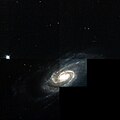NGC 7407
| Galaxie NGC 7407 | |
|---|---|
 | |
| SDSS-Aufnahme | |
| AladinLite | |
| Sternbild | Pegasus |
| Position Äquinoktium: J2000.0, Epoche: J2000.0 | |
| Rektaszension | 22h 53m 20,9s [1] |
| Deklination | +32° 07′ 50″ [1] |
| Erscheinungsbild | |
| Morphologischer Typ | Sbc[1] |
| Helligkeit (visuell) | 13,3 mag[2] |
| Helligkeit (B-Band) | 14,0 mag[2] |
| Winkelausdehnung | 2.00 × 0.9[2] |
| Positionswinkel | 152°[2] |
| Flächenhelligkeit | 13,8 mag/arcmin²[2] |
| Physikalische Daten | |
| Zugehörigkeit | LDCE 1520[1] |
| Rotverschiebung | 0,021435 ± 0,000013[1] |
| Radialgeschwindigkeit | (6426 ± 4) km/s[1] |
| Hubbledistanz H0 = 73 km/(s • Mpc) | (296 ± 21) · 106 Lj (90,9 ± 6,4) Mpc [1] |
| Durchmesser | 170.000 Lj[3] |
| Geschichte | |
| Entdeckung | Édouard Stephan |
| Entdeckungsdatum | 13. September 1873 |
| Katalogbezeichnungen | |
| NGC 7407 • UGC 12230 • PGC 69922 • CGCG 495-042 / 496-005 • MCG +05-54-002 • IRAS 22510+3151 • 2MASX J22532041+3207529 • | |
NGC 7407 ist eine Spiralgalaxie vom Hubble-Typ Sbc im Sternbild Pegasus am Nordsternhimmel. Sie ist schätzungsweise 296 Millionen Lichtjahre von der Milchstraße entfernt und hat einen Durchmesser von etwa 170.000 Lichtjahren.
Die Typ-IaP-Supernova SN 2003gq wurde hier beobachtet.[4]
Das Objekt wurde am 13. September 1873 von dem Astronomen Édouard Jean-Marie Stephan mit seinem 31,5-Zoll-Spiegelteleskop entdeckt und später von Johan Dreyer in seinen New General Catalogue aufgenommen.[5]
- Aufnahme des Hubble-Weltraumteleskops
Weblinks
Einzelnachweise
Auf dieser Seite verwendete Medien
Autor/Urheber: Sloan Digital Sky Survey, Lizenz: CC BY 4.0

Angle of view: 4' × 4' (0.3" per pixel), north is up.
Details on the image processing pipeline: https://www.sdss.org/dr14/imaging/jpg-images-on-skyserver/NGC 7407 galaxy by Hubble space telescope


